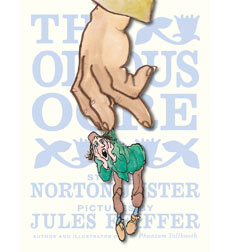
The Odious Ogre written by Norton Juster and illustrated by Jules Feiffer marks the return of the duo that brought us the tale of The Phantom Tollbooth. With the tale of The Odious Ogre, they do not disappoint their readers. The story is about an Ogre whose reputation precedes him throughout nearby towns. Everyone is terribly frightened of the Ogre for good reasons. When he enters towns and villages, he terrorizes the place and feasts on the population. The people run and hide in hopes of escaping the terrible Ogre, but usually most are not successful. He finds it easy to find dinner and to frighten the people. In fact, the Ogre feels unstoppable because everyone is scared of him and no one tries to stop him. It is all just too easy for him. However, one day, he comes across a small cottage removed from the rest of the town. There he runs into a young woman who has no idea about the Ogre’s reputation. So the young woman is kind to the Ogre, and soon he is wondering if he is really all that unstoppable.
Norton Juster does a great job of telling this story in a fun way that kids will enjoy. This story is written in a fun and clever way that will be sure to grab children’s attention. The language of the book is wonderful and really keeps the story flowing. This is a wonderful read aloud book where the words easily roll off of your tongue. Juster’s use of descriptive language is just wonderful. I loved the combination of words Juster uses to describe the Ogre, and the way he describes the people’s perception of the Ogre is also impeccably done in my opinion. Sometimes you just can’t help but find yourself smile while reading this book. Juster does use some words that many young children will have no idea of what they mean, but it just offers children a great opportunity to expand their vocabulary. The message of the book is also a good one for children. This book shows you that kindness can go a long way, which is an important lesson for kids to learn.
The illustrations in this book are amazing. Jules Feiffer does a great job of illustrating just how hideous and disgusting the Ogre is. He also does a good job of scaling the illustrations. From the illustrations, you can really get a sense of how big the Ogre is. I especially, like the pages where you cannot see the entirety of the Ogre, but only his bottom half because that is just how gigantic he is. Feiffer’s watercolor illustrations really do a fantastic job of bringing the story to life. The illustrations are really eye catching and you just can’t help but to stop and look at them. The layout of the book is also done very well. The text and the illustrations are integrated very well with one another. I also really liked how in some of the pages there was the incorporation of word bubbles in the illustrations.
Overall, I thought that this book was amazing. Norton Juster and Jules Feiffer both did a wonderful job of bringing the story to life. Both the language and the illustrations of the story are fantastic. I would highly recommend this book to others because it is a fun read aloud that both children and adults would really enjoy.
La'Toya















